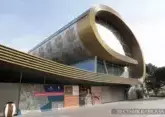As the British Empire expanded in the 19th century, the English planted their easels across the lands on which the sun would never set. Flora, fauna, landscapes — the watercolours depict an age gone by, stretching from Kuala Lumpur to Kingston-upon-Thames, from Islamabad to Ipswich. Many have been lost or, left to museums, have lingered in dusty backrooms. But for Javad Marandi, an Iranian-born entrepreneur, to leave the works to decay would be to erase a form of social history. Financial Times reports in its article Saving the world’s watercolours one byte at a time that before photography, watercolours weren’t so much a form of art as a form of recording everything from flora and fauna to the landscapes. They were a very good documentation of how the world was and unfortunately, because of their very nature, they tend to deteriorate in quality as time goes by.
In attempt to preserve the works, this year Marandi — perhaps best known in the UK for his half-share in the Soho Group restaurant business as well as owning members’ club and hotel Soho Farm House in Oxfordshire — is funding The Watercolour World, a foundation dedicated to digitising watercolours across the globe. “Imagine having hundreds of thousands of images online for people who want to find out about Naples in the 1920s — they can see how history changes,” says Marandi, who is chipping in £400,000 a year.
The project is the very definition of a Sisyphean task, given the millions of watercolours in existence, but Marandi is undaunted by the scale of the venture. “We’re starting with geographical locations, with Great Britain first,” he explains. “Then wherever we have connections and can gain access to the collections around the world.”
Access has been boosted by the patronage of Prince Charles, a keen watercolourist himself, and his wife, the Duchess of Cornwall. “Once you have [their] patronage, the museums and organisations take you much more seriously [and] are much more willing to help and co-operate.”
It is an intriguing venture for Marandi, whose property interests include the Sofitel hotel in Brussels and co-ownership of a CenterParc holiday park in Moselle, France. Yet his family’s history has been punctuated by periods of upheaval. In 1920, his grandfather, Alimorad, left the then Soviet republic of Azerbaijan as the Bolshevik revolution swept across the region. Then, almost 60 years later, in the wake of the Islamic revolution in Iran, Marandi — aged 11 — and his immediate family exchanged relative luxury in Tehran for a small flat in Notting Hill, west London.
“It was very difficult; when I came to England couldn’t speak a word of English,” Marandi says. “We had never planned to live abroad, as this was a country with 2,500 years of history and it had always been a monarchy. Who would have thought that the monarchy would turn into some sort of . . . well, whatever the current government is.”
I wonder then, playing armchair psychiatrist, if these experiences, both personal and those that have affected three generations of his family, have left him with a need for permanence, the need to ensure that these documents of the past are preserved in a way that his own history was not? “You never want it to be repeated ever again,” Marandi says. “So as much as possible, you try to stabilise your life. All we aim for in life is stability and the stability we want to give to our children.
“It makes you a lot more risk averse,” he adds.
Sure, I agree, but he certainly took many risks in establishing his career early on: how does that square with his position now?
“Obviously at some point you have to take some risks in order to move forward,” he says, “but always consolidating. Everything is not on the line all the time — you become a lot more conservative. Obviously, at the beginning, you have nothing to lose, so you can pretty much risk everything.”
We had first met late last year in the splendour of 5 Hertford Street, a private members’ club in London’s Mayfair. He had arrived with his friend Darius Sanai, a fellow Iranian exile in London, now editor-in-chief at magazine publisher Condé Nast, and immediately commandeered the table. We had shared similar experiences a few years apart in the Caucuses and, as the wine flowed, we swapped stories of living and working in what were, at times, very difficult conditions.
Marandi’s story almost began in Turkey. He had applied for a finance job at Coca-Cola — “lied, you mean”, he laughs. “I was interviewed by 11 people in Vienna, but none of them spoke Turkish [a prerequisite for the job]. I speak Azeri, which while it shares certain roots with Turkish, is not the same language. But I thought if I get the job I’ll learn it in a month.”
His ploy ended in his final interview with Muhtar Kent, the Turkish-American businessman who went on to become chief executive and chairman of Coca-Cola. Kent told him he was not going to offer him the position but, impressed by Marandi’s chutzpah, sent him instead to central Asia and the Caucasus. It was 1992 and Marandi was 24. He remained with Coca-Cola for two years, buzzing round Uzbekistan, Georgia, Kazakhstan and Azerbaijan, before being headhunted by tobacco group Philip Morris International.
Those were turbulent times for the newly independent state of Azerbaijan, and after five years Marandi moved to form his own logistics business, distributing cigarettes and other consumer goods across the region.
Today, he is known as an investor and property developer in the UK and continental Europe, with a house in London’s Eaton Square shared with his wife and three children. Interestingly, it is also stuffed with modern art — hyper-contemporary works that Marandi is gleefully happy to scorn, to the despair of his wife, Narmina.
“She finds it very upsetting when I go into this spiel about value — the true value of this modern art. But I just don’t understand it; I think it’s a bubble. I don’t understand why certain paintings are worth tens of millions of pounds and all it is is three spots and some cuts on a canvas.”
If he had his choice, Marandi jokes, there would be posters on the walls. “I would probably buy some of the Old Masters and I know that doesn’t sound right, but they are very much undervalued and supply is limited,” he says. “[Andy] Warhol was making 90 paintings a day — he was a like a factory — and some of the paintings were done by his friends. So I can’t for the life of me understand why one of those 90 made in a day is now worth millions.”
This makes his decision to launch The Watercolour World all the more intriguing. Preserving watercolours is not about ensuring the art is saved for the next generation but about “recording history that we’re losing”, he says. “Historic events, scientific facts or the changes to the environment — this information, this visual information, we are losing and it’s a shame.
“While we’re very excited about hip and cool and trendy stuff, instead with relatively little money we are preserving our history.”










